The Sink Bowls Market is estimated to be valued at USD 4.0 billion in 2025 and is projected to reach USD 6.2 billion by 2035, registering a compound annual growth rate (CAGR) of 4.4% over the forecast period.
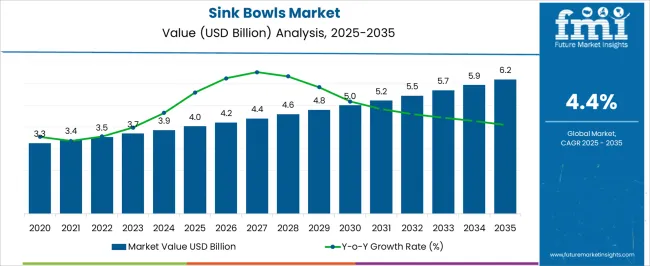
| Metric | Value |
|---|---|
| Sink Bowls Market Estimated Value in (2025 E) | USD 4.0 billion |
| Sink Bowls Market Forecast Value in (2035 F) | USD 6.2 billion |
| Forecast CAGR (2025 to 2035) | 4.4% |
The sink bowls market is witnessing consistent expansion supported by rapid urbanization, increasing residential construction, and a rising focus on modular kitchen designs. Growing consumer preference for durable, low maintenance, and aesthetically appealing materials is shaping demand across both residential and commercial applications.
Technological advancements in fabrication and surface finishing have enabled manufacturers to provide high performance sink bowls with enhanced resistance to stains, corrosion, and scratches. Shifts in lifestyle trends toward compact housing and modern kitchen aesthetics are also influencing product adoption.
Additionally, the integration of eco friendly production practices and recyclable materials is strengthening the sustainability credentials of leading products. With evolving consumer expectations for functional designs and smart home integration, the market outlook remains positive as demand continues to rise across urban centers and premium housing projects.
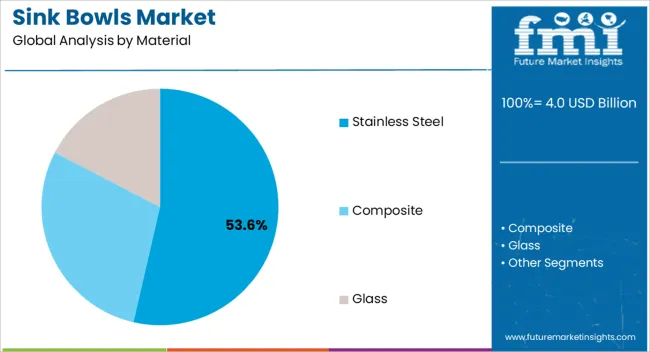
The stainless steel segment is expected to hold 53.60% of the total market revenue by 2025, establishing it as the dominant material type. Its popularity is driven by high durability, resistance to corrosion, and cost effectiveness, which make it suitable for both residential and commercial kitchens.
Ease of cleaning and compatibility with modern kitchen appliances further enhance its acceptance. Manufacturers continue to innovate with textured finishes, noise reduction coatings, and premium design aesthetics, strengthening the appeal of stainless steel sink bowls.
As sustainability awareness grows, the recyclable nature of stainless steel adds to its value proposition, reinforcing its dominance in the material category.
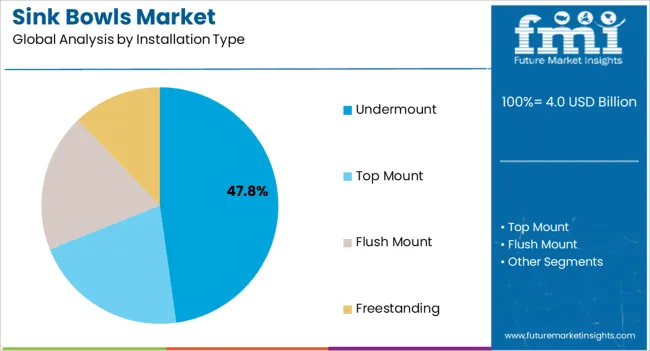
The undermount installation type segment is projected to account for 47.80% of market revenue by 2025, making it the leading category. This preference is largely due to its seamless design, ease of cleaning, and superior visual integration with countertops.
Undermount sinks provide a premium finish that aligns with the growing demand for modern and minimalist kitchen aesthetics. Their ability to maximize counter space while offering a clean and clutter free look has further encouraged adoption.
Increasing popularity of quartz and granite countertops, which pair effectively with undermount designs, has reinforced this segment’s leadership.
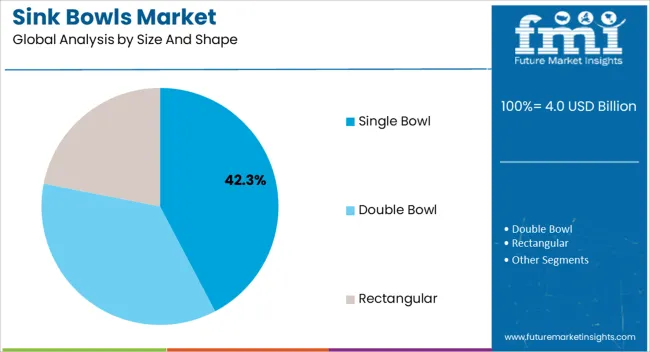
The single bowl segment is anticipated to capture 42.30% of the total market revenue by 2025 within the size and shape category, positioning it as the leading preference. This format offers functional simplicity, ample washing space, and adaptability for compact kitchens where space efficiency is crucial.
Single bowl sinks are increasingly preferred in urban housing developments where streamlined designs and efficient space utilization are priorities. Their ease of installation and cost competitiveness add to their appeal for both residential renovations and new constructions.
These advantages continue to drive demand, securing single bowl sinks as the most widely adopted size and shape configuration.
The global demand for sink bowls is projected to increase at a CAGR of 2.3% during the forecast period between 2020 and 2025, reaching a total of USD 6.2 billion in 2035.
According to Future Market Insights, a market research and competitive intelligence provider, the sink bowls market was valued at USD 4 billion in 2025.
The growing adoption of smart sink bowls is driven by the increasing integration of smart home technology into residential spaces, which in turn is anticipated to boost the growth of the sink bowls market during the forecast period.
Smart sink bowls provide convenient and time-saving features that simplify daily tasks. Touchless faucets eliminate the need for manual operation, allowing users to start and stop the water flow with a simple gesture.
Automated water temperature control ensures consistent and comfortable water temperatures, eliminating the need for manual adjustments. The features enhance user convenience and efficiency in the kitchen or bathroom, making tasks like handwashing, dishwashing, or food preparation more seamless and enjoyable.
The smart sink bowls promote enhanced hygiene and sanitation practices. Touchless operation minimizes the need for direct contact with the faucet, reducing the potential transmission of germs and bacteria. Integrated soap dispensers in smart sink bowls provide measured amounts of soap, ensuring proper hand hygiene. Some smart sink bowls also incorporate UV-C or other disinfection technologies to sterilize the sink surfaces, further enhancing cleanliness and reducing the risk of contamination.
Smart sink bowls often come equipped with water-saving features that contribute to sustainable water usage. The features include flow sensors that detect the presence of hands or objects and adjust the water flow accordingly, as well as timers that automatically shut off the water after a designated period of time. Smart sink bowls help conserve water resources and promote eco-friendly practices, by optimizing water usage and reducing wastage.
Increasing Demand for Stylish and Functional Sink Solutions to Fuel the Market Growth
The continually rising demand for stylish and functional sink solutions is driven by consumers' desire to elevate the aesthetic appeal of their kitchen and bathroom spaces. Sink bowls have evolved from being solely utilitarian elements to becoming important design features within these spaces.
Consumers are seeking sink bowls that seamlessly integrate with the overall design and style of their kitchens or bathrooms, and prefer sink bowls that complement the existing décor, whether it's a contemporary, traditional, or transitional design theme. The focus is on creating a cohesive and visually appealing space where the sink bowl serves as a design centerpiece.
There is a growing demand for sink bowls with unique shapes and sizes that deviate from traditional rectangular or circular designs. Irregular geometric shapes, asymmetrical designs, and custom sizes allow consumers to add a touch of individuality and uniqueness to their spaces. The distinctive sink bowl designs become conversation starters and create visually interesting focal points.
Sustainability and Eco-Friendly Materials to Accelerate the Market Growth
The growing emphasis on sustainability and eco-friendliness in the construction and home improvement industry has influenced consumer preferences toward eco-friendly sink bowls. The trend reflects a broader shift towards environmentally conscious choices and a desire to reduce the ecological footprint associated with everyday products.
Consumers are actively seeking sink bowls made from sustainable and eco-friendly materials. Materials like recycled glass, bamboo, and stainless steel are gaining popularity due to their renewable or recycled nature. Recycled glass sink bowls repurpose discarded glass, reducing waste and conserving resources. Bamboo, a fast-growing and renewable material, offers a sustainable alternative to traditional wood-based sink bowls. Stainless steel, a highly recyclable material, is known for its durability and longevity, reducing the need for frequent replacements.
Eco-friendly sink bowls are designed to have a minimal environmental impact throughout their lifecycle. Sustainable materials minimize the extraction of raw resources and reduce energy consumption during production. Eco-friendly manufacturing processes strive to minimize waste generation, water usage, and harmful emissions. Consumers, by choosing environmentally conscious options, can contribute to reducing their carbon footprint and preserving natural resources.
Limited Consumer Awareness Regarding Sink Bowls to Restrain the Market Growth
Limited consumer awareness is a significant factor that is expected to restrain the growth of the sink bowls market over the analysis period. Traditional sink designs, such as stainless steel or porcelain sinks, have been widely used and familiar to consumers for many years. Consumers tend to have a higher level of awareness and familiarity with these conventional options. They, as a result, may not actively seek information or explore alternative options like sink bowls, especially if they are not aware of the benefits or unique features they provide.
The sink bowls market may not have received as much marketing and promotional attention as other household products. Manufacturers and retailers may focus their marketing efforts on more mainstream products, leaving sink bowls with limited exposure to the wider consumer audience. Insufficient marketing activities can contribute to a lack of consumer awareness about the range of options and features available in the sink bowls market.
Sink bowls often require physical presence or visual demonstration to effectively showcase their design, materials, and features. The availability and prominence of sink bowl displays in retail stores or showrooms may be limited compared to traditional sink options. Consumers may not have the opportunity to see and experience sink bowls firsthand, which can hinder their awareness and understanding of the product.
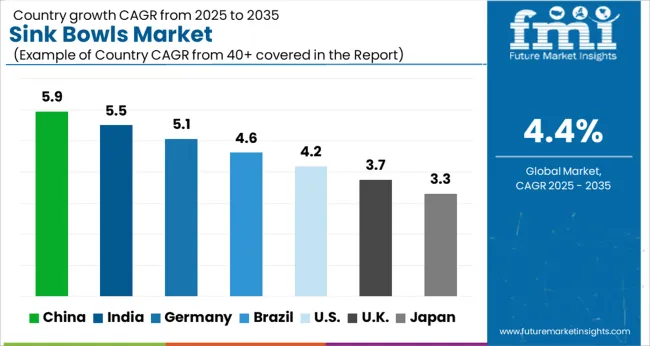
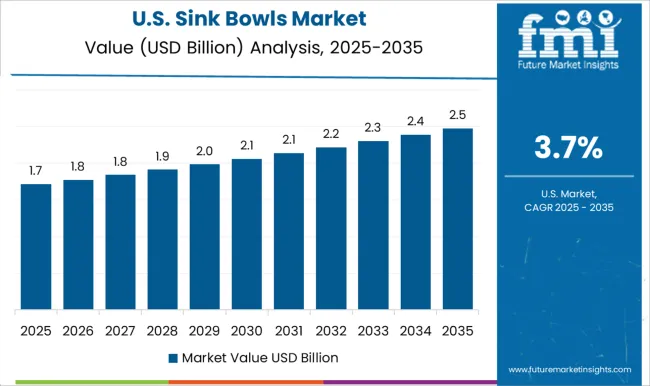
Increasing Focus on Aesthetics in Kitchen in North America to Fuel the Market Growth
The sink bowls market in North America is expected to accumulate a prominent CAGR of 4.3% in 2025.
The regional market growth is attributed to the factors such as renovation and remodeling activities. Renovation and remodeling projects in residential and commercial sectors drive the demand for sink bowls. North America has a robust construction industry, with a significant number of renovation and remodeling activities taking place. The homeowners and businesses often consider replacing conventional sinks with modern and aesthetically appealing sink bowls, as they seek to upgrade their spaces.
The United States, for instance, experiences a high level of renovation and remodeling activities across various industries, including residential, hospitality, and commercial sectors. This contributes to increased demand for sink bowls as part of the upgrade process.
The increasing focus on interior design aesthetics in kitchens and bathrooms has led to a greater demand for visually appealing sink bowls. Consumers are seeking unique and stylish sink bowl designs that complement their overall decor. The factor drives the growth of the regional market as sink bowls have transitioned from purely functional elements to design features.
Canadian consumers, for instance, place importance on design aesthetics in their homes. The demand for stylish sink bowls that align with the overall interior decor has been growing, contributing to market expansion.
North America has witnessed a growing emphasis on sustainability and eco-friendliness in the construction and home improvement sectors. Consumers are increasingly seeking sink bowls made from environmentally friendly materials, such as recycled glass or bamboo, that have minimal environmental impact, which in turn is projected to augment the market growth.
Rapi Urbanization and Infrastructure Development in the Region to Fuel the Market Growth
The sink bowls market in Asia Pacific is expected to accumulate the highest CAGR of 4.2% in 2025.
The Asia Pacific Sink Bowls market is expected to witness significant growth attributed to rapid urbanization and infrastructure development. The region is experiencing rapid urbanization, along with significant infrastructure development in residential, commercial, and hospitality sectors. The demand for sink bowls as part of kitchen and bathroom installations increases, as new buildings are constructed and existing infrastructure is upgraded.
India, for instance, has been witnessing rapid urbanization and infrastructure growth, particularly in its major cities. The demand for sink bowls in residential and commercial projects rises, as the country experiences increased construction activity.
There is a noticeable shift in consumer preferences towards modern and contemporary kitchen and bathroom designs in the region. Consumers are increasingly moving away from traditional sink options and opting for sink bowls that offer unique shapes, colors, and materials.
Japan, for instance, with its penchant for minimalistic and functional design, has seen increased adoption of modern sink bowls. Japanese consumers appreciate the blend of functionality and aesthetics offered by sink bowls.
The thriving hospitality and tourism industry in the region, escalates the demand for high-quality and visually appealing sink bowls in hotels, resorts, and other accommodation facilities.
Thailand, for instance, is a popular tourist destination, attracting a significant number of visitors each year. The growth of the hospitality industry in the country creates a demand for sink bowls in hotels and resorts, as they aim to provide stylish and comfortable amenities to their guests.
Composite Material Segment to beat Competition in Untiring Market
On the basis of material, the market is dominated by composite segment, which is expected to hold a CAGR of 4.3% over the analysis period.
Composite sink bowls are known for their durability and resistance to scratches, stains, and heat, which makes them a popular choice for busy kitchens or high-traffic areas where the sink is subjected to heavy use.
Composite sink bowls offer a wide range of colors, patterns, and textures, allowing homeowners to find a design that complements their kitchen or bathroom decor. The versatility of composite materials enables the creation of unique and visually appealing sink bowl options.
The sink bowls are generally easy to clean and maintain. They are non-porous, which helps prevent the absorption of stains and odors. Their smooth surfaces make it easier to wipe away dirt and grime, requiring minimal effort for upkeep.
The bowls are often resistant to chemicals commonly found in household cleaning products. The resistance ensures that the sink bowl's appearance and performance are not compromised when using standard cleaning solutions.
Kitchen Sinks Segment to Drive the Sink Bowls Market
Based on the application, the kitchen sinks segment is expected to expand at rapid rate of 4.2% CAGR over the analysis period.
The segmental growth can be attributed to the increasing Focus on kitchen renovations. There is a higher demand for stylish and functional kitchen sinks, with the growing trend of kitchen renovations and remodeling. Homeowners are looking for sink bowls that not only provide utility but also enhance the overall aesthetics of their kitchen.
The shift towards healthier eating and increased home cooking has led to higher kitchen usage, and as a result, there is a need for durable and versatile kitchen sinks that can withstand heavy usage and accommodate various cooking and cleaning tasks.
Kitchen sinks with innovative features and designs that offer multiple functionalities are gaining popularity, which includes sink bowls with integrated cutting boards, colanders, or accessories that enhance the efficiency and convenience of food preparation and cleanup.
Kitchen sinks that are easy to clean and maintain are in high demand. Consumers are looking for sink bowls with smooth surfaces, stain-resistant materials, and anti-bacterial properties, ensuring a hygienic environment in the kitchen.
Sink bowls market startup players are adopting various marketing strategies such as new product launches, geographical expansion, merger and acquisitions, partnerships and collaboration to to create a larger customer base.
For instance:
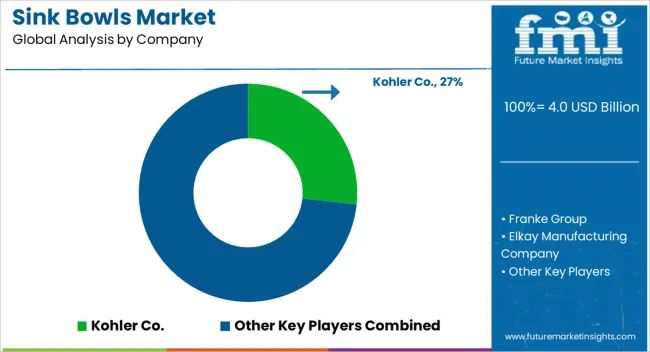
Prominent players in the sink bowls market are Kohler Co., Hafele, Franke Group, Elkay Manufacturing Company, MR Direct, Blanco, Teka Group, Matte Stone, Duravit AG, Kraus, Roca Sanitario, S.A., Villeroy & Boch AG, American Standard Brands, and Moen Incorporated, among others.
Recent Developments:
| Report Attribute | Details |
|---|---|
| Growth Rate | CAGR of 4.4% from 2025 to 2035 |
| Market Value in 2025 | USD 4.0 billion |
| Market Value in 2035 | USD 6.2 billion |
| Base Year for Estimation | 2025 |
| Historical Data | 2020 to 2025 |
| Forecast Period | 2025 to 2035 |
| Quantitative Units | Revenue in USD billion and CAGR from 2025 to 2035 |
| Report Coverage | Revenue Forecast, Company Ranking, Competitive Landscape, Growth Factors, Trends, and Pricing Analysis |
| Segments Covered | Material, Installation Type, Size and Shape, Application, Features |
| Regions Covered | North America; Latin America; Europe; Asia Pacific; Middle East & Africa |
| Key Countries Profiled | Germany, United Kingdom, France, Spain, Italy, United States, Canada, Brazil, Mexico, India, China, Japan, South Korea, Singapore, Thailand, Indonesia, Australia, New Zealand, Rest of Asia Pacific |
| Key Companies Profiled | Kohler Co.; Franke Group; Elkay Manufacturing Company; Blanco; Teka Group; Duravit AG; Roca Sanitario, S.A.; Villeroy & Boch AG; American Standard Brands; Moen Incorporated |
The global sink bowls market is estimated to be valued at USD 4.0 billion in 2025.
The market size for the sink bowls market is projected to reach USD 6.2 billion by 2035.
The sink bowls market is expected to grow at a 4.4% CAGR between 2025 and 2035.
The key product types in sink bowls market are stainless steel, composite and glass.
In terms of installation type, undermount segment to command 47.8% share in the sink bowls market in 2025.






Full Research Suite comprises of:
Market outlook & trends analysis
Interviews & case studies
Strategic recommendations
Vendor profiles & capabilities analysis
5-year forecasts
8 regions and 60+ country-level data splits
Market segment data splits
12 months of continuous data updates
DELIVERED AS:
PDF EXCEL ONLINE
Sinker Type EDM Market Size and Share Forecast Outlook 2025 to 2035
Sinker Drill Market Size and Share Forecast Outlook 2025 to 2035
Hand Sinks Market - Hygiene & Compliance in Foodservice 2025 to 2035
Water Sink Market Size and Share Forecast Outlook 2025 to 2035
Underbar Sinks Market - Space-Saving & Functional Bar Solutions 2025 to 2035
Commercial Sink Market Size and Share Forecast Outlook 2025 to 2035
Janitorial Sinks Market Growth - Trends & Forecast 2025 to 2035
Compartment Sinks Market - Hygiene & Efficient Kitchen Workflow 2025 to 2035
All-In-One Under Sink Water Purifier Market Size and Share Forecast Outlook 2025 to 2035
Eco Bowls Market Analysis - Size and Share Forecast Outlook 2025 to 2035
Bagasse Bowls Market Size and Share Forecast Outlook 2025 to 2035
Market Share Insights for Bagasse Bowls Providers
Sugarcane Fiber Bowls Market – Growth & Demand 2025 to 2035
Aquarium & Fish Bowls Market Growth - Trends & Forecast to 2035

Thank you!
You will receive an email from our Business Development Manager. Please be sure to check your SPAM/JUNK folder too.
Chat With
MaRIA